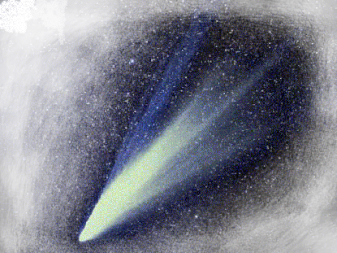According to Fred Whipple, Comets are dirty snowballs that spend most of their time far from the Sun.
The structure of a typical comet includes several distinct parts.
•
nucleus -
V
the actual, solid part of the comet, usually 3 -5 km in size
•
coma (or head) -
V
the glowing, temporary atmosphere of the comet when near the Sun
•
hydrogen envelope -
V
extending for thousands of kilometers it consists of H atoms
•
gas tail -
V
also known as the ion tail, it is molecular fragments glowing by emission
•
dust tail -
V
generally yellow in color, it is caused by dust grains reflecting sunlight
The two types of comet tails are sometimes refered to as type 1 and type 2. The two parts of the tail, a gas tail and a dust
tail.do not always show themselves in every comet. Many comets never do develop much more than just a coma. Hale-Bopp
showed the two types of tails particularly well. Sometimes the orbi
t of a comet is changed by the gravitational influence of a massive planet such as Jupiter or Saturn. When that happens, they
can become frequent and familiar visitors to the inner solar system. Comet Encke, for example circles the Sun in just 3.3
years.
Halley’s comet is the best example of a short-period comet. With its 76 year orbital period, most people will have a chance
to see it at least once in their lifetime. But at any time, there may be dozens of comets that can be seen in modest sized
telescopes. Here are a couple that are currently visible. Ray Kronk has a definitive page for researching the history of
observing comets.




















